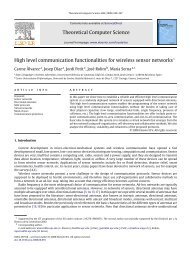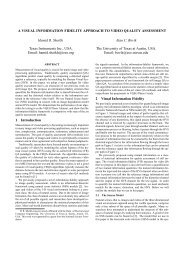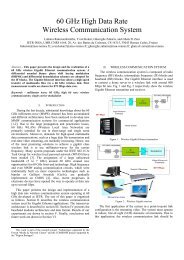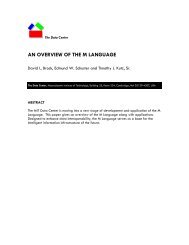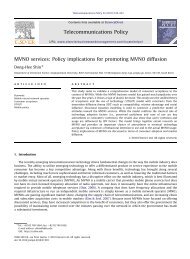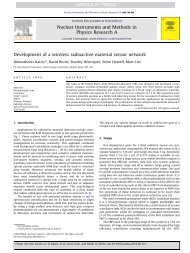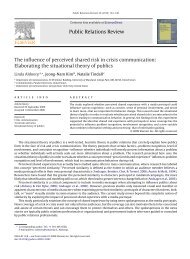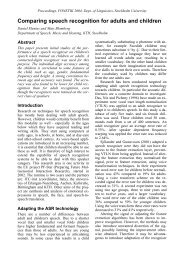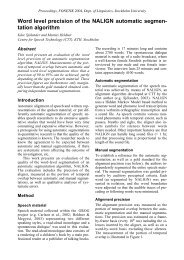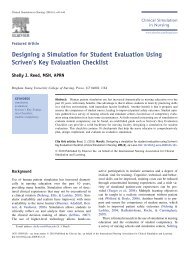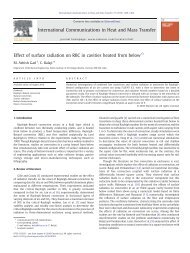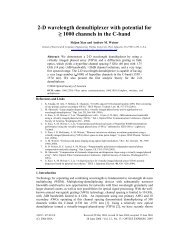A survey on clustering algorithms for wireless sensor networks
A survey on clustering algorithms for wireless sensor networks
A survey on clustering algorithms for wireless sensor networks
You also want an ePaper? Increase the reach of your titles
YUMPU automatically turns print PDFs into web optimized ePapers that Google loves.
Sensor nodes<br />
Base-stati<strong>on</strong><br />
Command Node<br />
Command Node<br />
Command<br />
Node<br />
Command Node<br />
Command<br />
Node<br />
Fig. 1. An articulati<strong>on</strong> of a sample WSN architecture <strong>for</strong> a military<br />
applicati<strong>on</strong>.<br />
c<strong>on</strong>strained and their batteries cannot be recharged. There<strong>for</strong>e,<br />
designing energy-aware <strong>algorithms</strong> becomes an<br />
important factor <strong>for</strong> extending the lifetime of <strong>sensor</strong>s.<br />
Other applicati<strong>on</strong> centric design objectives, e.g. high fidelity<br />
target detecti<strong>on</strong> and classificati<strong>on</strong>, are also c<strong>on</strong>sidered<br />
[10].<br />
Grouping <strong>sensor</strong> nodes into clusters has been widely pursued<br />
by the research community in order to achieve the network<br />
scalability objective. Every cluster would have a<br />
leader, often referred to as the cluster-head (CH). Although<br />
many <strong>clustering</strong> <strong>algorithms</strong> have been proposed in the literature<br />
<strong>for</strong> ad-hoc <strong>networks</strong> [11–15], the objective was mainly<br />
to generate stable clusters in envir<strong>on</strong>ments with mobile<br />
nodes. Many of such techniques care mostly about node<br />
reachability and route stability, without much c<strong>on</strong>cern<br />
about critical design goals of WSNs such as network l<strong>on</strong>gevity<br />
and coverage. Recently, a number of <strong>clustering</strong> <strong>algorithms</strong><br />
have been specifically designed <strong>for</strong> WSNs [16–20].<br />
These proposed <strong>clustering</strong> techniques widely vary depending<br />
<strong>on</strong> the node deployment and bootstrapping schemes, the<br />
pursued network architecture, the characteristics of the<br />
CH nodes and the network operati<strong>on</strong> model. A CH may<br />
be elected by the <strong>sensor</strong>s in a cluster or pre-assigned by the<br />
network designer. A CH may also be just <strong>on</strong>e of the <strong>sensor</strong>s<br />
or a node that is richer in resources. The cluster membership<br />
may be fixed or variable. CHs may <strong>for</strong>m a sec<strong>on</strong>d tier network<br />
or may just ship the data to interested parties, e.g. a<br />
base-stati<strong>on</strong> or a command center.<br />
In additi<strong>on</strong> to supporting network scalability, <strong>clustering</strong><br />
has numerous advantages. It can localize the route set up<br />
within the cluster and thus reduce the size of the routing<br />
table stored at the individual node [21]. Clustering can also<br />
c<strong>on</strong>serve communicati<strong>on</strong> bandwidth since it limits the<br />
scope of inter-cluster interacti<strong>on</strong>s to CHs and avoids<br />
redundant exchange of messages am<strong>on</strong>g <strong>sensor</strong> nodes<br />
[22]. Moreover, <strong>clustering</strong> can stabilize the network topology<br />
at the level of <strong>sensor</strong>s and thus cuts <strong>on</strong> topology maintenance<br />
overhead. Sensors would care <strong>on</strong>ly <strong>for</strong> c<strong>on</strong>necting<br />
A.A. Abbasi, M. Younis / Computer Communicati<strong>on</strong>s 30 (2007) 2826–2841 2827<br />
with their CHs and would not be affected by changes at the<br />
level of inter-CH tier [23]. The CH can also implement<br />
optimized management strategies to further enhance the<br />
network operati<strong>on</strong> and prol<strong>on</strong>g the battery life of the individual<br />
<strong>sensor</strong>s and the network lifetime [22]. A CH can<br />
schedule activities in the cluster so that nodes can switch<br />
to the low-power sleep mode most of the time and reduce<br />
the rate of energy c<strong>on</strong>sumpti<strong>on</strong>. Sensors can be engaged<br />
in a round-robin order and the time <strong>for</strong> their transmissi<strong>on</strong><br />
and recepti<strong>on</strong> can be determined so that the <strong>sensor</strong>s reties<br />
are avoided, redundancy in coverage can be limited and<br />
medium access collisi<strong>on</strong> is prevented [24–27]. Furthermore,<br />
a CH can aggregate the data collected by the <strong>sensor</strong>s in its<br />
cluster and thus decrease the number of relayed packets<br />
[28].<br />
In this paper, we opt to categorize <strong>clustering</strong> <strong>algorithms</strong><br />
proposed in the literature <strong>for</strong> WSNs. We report <strong>on</strong> the state<br />
of the research and summarize a collecti<strong>on</strong> of published<br />
schemes stating their features and shortcomings. We also<br />
compare the different approaches and analyze their applicability.<br />
In the next secti<strong>on</strong>, we discuss the different classificati<strong>on</strong>s<br />
of <strong>clustering</strong> techniques and enumerate a set of<br />
attributes <strong>for</strong> categorizing published <strong>algorithms</strong>. In Secti<strong>on</strong><br />
3, we summarize a collecti<strong>on</strong> of <strong>clustering</strong> <strong>algorithms</strong> <strong>for</strong><br />
WSNs and present classificati<strong>on</strong> of the various approaches<br />
pursued. Finally, Secti<strong>on</strong> 4 c<strong>on</strong>cludes the paper.<br />
2. Tax<strong>on</strong>omy of <strong>clustering</strong> attributes<br />
Clustering techniques <strong>for</strong> WSNs proposed in the literature<br />
can be generally classified based <strong>on</strong> the overall network<br />
architectural and operati<strong>on</strong> model and the objective<br />
of the node grouping process including the desired count<br />
and properties of the generated clusters. In this secti<strong>on</strong><br />
we discuss the different classificati<strong>on</strong>s and present tax<strong>on</strong>omy<br />
of a <strong>clustering</strong> attributes. We later use such attributes<br />
to categorize and compare the <str<strong>on</strong>g>survey</str<strong>on</strong>g>ed <strong>clustering</strong><br />
<strong>algorithms</strong>.<br />
2.1. Classifying <strong>clustering</strong> techniques<br />
2.1.1. Network model<br />
Different architectures and design goals/c<strong>on</strong>straints<br />
have been c<strong>on</strong>sidered <strong>for</strong> various applicati<strong>on</strong>s of WSNs.<br />
The following enlists some the relevant architectural<br />
parameters and highlight their implicati<strong>on</strong>s <strong>on</strong> network<br />
<strong>clustering</strong>.<br />
• Network dynamics: Basically WSNs c<strong>on</strong>sist of three<br />
main comp<strong>on</strong>ents: <strong>sensor</strong> nodes, base-stati<strong>on</strong> and m<strong>on</strong>itored<br />
events. Aside from the few setups that utilize mobile<br />
<strong>sensor</strong>s [29,30], most of the network architectures assume<br />
that <strong>sensor</strong> nodes are stati<strong>on</strong>ary [19,31,32]. Sometimes it<br />
is deemed necessary to support the mobility of base-stati<strong>on</strong><br />
or CHs. Node mobility would make <strong>clustering</strong> very challenging<br />
since the node membership will dynamically<br />
change, <strong>for</strong>cing clusters to evolve over time. On the other<br />
hand, the events m<strong>on</strong>itored by a <strong>sensor</strong> can be either



